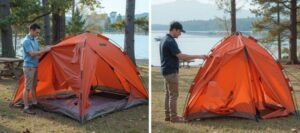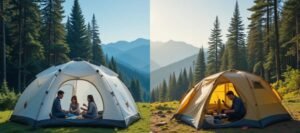Introduction
Camping can be an incredible way to connect with nature, relax, and escape the stress of daily life. However, for beginners, the experience can quickly turn frustrating due to poor preparation and avoidable mistakes. Without proper knowledge, a trip that should be enjoyable can become uncomfortable, stressful, or even dangerous.
Many first-time campers underestimate the importance of research, gear selection, and environmental awareness. Simple missteps—such as choosing the wrong campsite, forgetting essential equipment, or failing to prepare for bad weather—can quickly derail a trip. Fortunately, these mistakes are entirely preventable with the right approach.
In this guide, we’ll highlight the most common mistakes beginners make when camping and provide practical solutions to avoid them. Whether you’re planning your first camping trip or looking to refine your skills, these tips will ensure a smoother, safer, and more enjoyable outdoor experience.
1. Poor Planning and Lack of Research
🔹 Mistake: Not Researching the Campsite Beforehand
One of the biggest mistakes new campers make is failing to research their destination. Many assume that all campgrounds offer the same experience, but every campsite is unique—some may have strict regulations, require reservations, or lack essential amenities.
🔹 Why It’s a Problem
Without prior research, you may encounter:
- Unexpected restrictions, such as fire bans, permit requirements, or pet prohibitions.
- Inadequate facilities, like a lack of restrooms, potable water, or designated fire pits.
- Unpredictable weather conditions, which can turn a pleasant trip into a miserable one.
- Safety hazards, including bear activity, flash flood zones, or extreme temperatures.
🔹 How to Avoid It
✅ Check the official website of the campsite or park for regulations, amenities, and availability.
✅ Look at recent reviews from other campers to get insights into real conditions.
✅ Use camping apps like AllTrails, Gaia GPS, or The Dyrt to find detailed maps and user experiences.
✅ Monitor the weather forecast for potential rain, extreme temperatures, or strong winds before your trip.
2. Choosing the Wrong Camping Spot
🔹 Mistake: Pitching a Tent in an Inconvenient or Unsafe Location
A poorly chosen campsite can lead to discomfort, safety risks, and exposure to bad weather. Beginners often select a spot without considering the terrain, environmental factors, or long-term practicality.
🔹 Why It’s a Problem
- Uneven or sloped terrain makes sleeping uncomfortable and can cause water to pool inside the tent.
- Low-lying areas are prone to flooding, especially after rain.
- Exposed locations can leave you vulnerable to strong winds or intense sunlight.
- Proximity to water sources may seem ideal but can attract mosquitoes and wildlife searching for food.
🔹 How to Avoid It
✅ Choose a level, dry area that isn’t at the bottom of a hill or in a valley.
✅ Look for natural windbreaks like trees or rock formations to shield against wind.
✅ Stay at least 200 feet away from water sources to reduce the risk of insect bites and wildlife encounters.
✅ Check the ground for sharp rocks, roots, or uneven patches before setting up the tent.
3. Not Practicing Tent Setup at Home
🔹 Mistake: Setting Up the Tent for the First Time at the Campsite
Many first-time campers assume that assembling a tent is straightforward, only to struggle for hours at the campsite. A complicated or incorrect setup can lead to frustration, poor shelter, or even damaging the tent.
🔹 Why It’s a Problem
- Wasted time: Setting up camp takes longer than expected.
- Improper assembly: Mistakes can leave the tent unstable, vulnerable to wind, or poorly ventilated.
- Damaged equipment: Forcing tent poles or stretching fabric incorrectly can lead to tears and breakages.
🔹 How to Avoid It
✅ Set up your tent at home at least once before your trip to familiarize yourself with the process.
✅ Check for missing or damaged parts (stakes, poles, rainfly) before leaving.
✅ Learn how to secure the tent properly by staking it down correctly and using guylines for added stability.
✅ Practice taking it down and packing it efficiently so you can do it quickly at the campsite.
4. Bringing Too Much or Too Little Gear
🔹 Mistake: Overpacking or Forgetting Essentials
Packing for a camping trip can be overwhelming, leading to two common mistakes:
- Overpacking: Bringing unnecessary items that add weight and make transportation difficult.
- Underpacking: Forgetting critical gear, such as a sleeping bag, flashlight, or proper clothing.
🔹 Why It’s a Problem
- Too much gear makes it harder to move around and can clutter the campsite.
- Not enough gear can result in discomfort, inadequate protection from the elements, or even safety risks.
🔹 How to Avoid It
✅ Use a camping checklist that includes all essentials and excludes non-essential items.
✅ Prioritize multi-use gear, such as a lightweight sleeping pad that doubles as a seat cushion.
✅ Pack for the weather—bring appropriate layers rather than excessive clothing.
✅ Test carrying your backpack before the trip to ensure it’s not too heavy or cumbersome.
5. Not Dressing Properly for the Weather
🔹 Mistake: Wearing the Wrong Clothing for Outdoor Conditions
Beginners often underestimate how much temperatures can drop at night or fluctuate throughout the day. Improper clothing choices can lead to hypothermia, overheating, or general discomfort.
🔹 Why It’s a Problem
- Too few layers can lead to cold exposure, even in summer.
- Cotton clothing absorbs sweat and stays wet, increasing the risk of hypothermia.
- Improper footwear can cause blisters, discomfort, or injuries.
🔹 How to Avoid It
✅ Dress in layers:
- Base layer: Moisture-wicking material to keep skin dry.
- Mid layer: Insulating layer (like fleece) for warmth.
- Outer layer: Waterproof and windproof jacket.
✅ Choose synthetic or wool fabrics instead of cotton, which retains moisture.
✅ Bring an extra pair of socks to keep feet dry and prevent blisters.
✅ Wear sturdy, weather-appropriate footwear suited for hiking or uneven terrain.
6. Not Bringing Enough Water or Proper Food
🔹 Mistake: Underestimating Hydration and Meal Planning
Many beginners don’t bring enough water or fail to plan balanced meals, leading to dehydration, low energy, and digestive issues.
🔹 Why It’s a Problem
- Dehydration: Lack of water can cause fatigue, headaches, dizziness, and heat-related illnesses.
- Inadequate nutrition: Eating poorly can make you feel sluggish and affect your stamina.
- Food spoilage: Packing perishable food without proper storage leads to waste and potential food poisoning.
🔹 How to Avoid It
✅ Follow the “2-Liters Rule”: Bring at least 2 liters of water per person per day for drinking, plus extra for cooking and hygiene.
✅ Use portable water filters or purification tablets if drinking from natural sources.
✅ Plan easy, high-energy meals: Choose foods like dried fruits, nuts, energy bars, and dehydrated meals that are lightweight and nutrient-dense.
✅ Pack a backup food source, such as emergency rations or ready-to-eat meals.
Pro Tip: If camping in hot or high-altitude areas, increase your water intake to avoid dehydration.
7. Ignoring Fire Safety and Campfire Rules
🔹 Mistake: Mishandling Campfires or Ignoring Fire Regulations
Campfires can enhance the camping experience, but misusing fire is one of the leading causes of wildfires and camping accidents.
🔹 Why It’s a Problem
- Uncontrolled fires can spread quickly in dry conditions.
- Improperly extinguished fires may rekindle and become dangerous.
- Using wet or green wood creates excess smoke and inefficient burning.
🔹 How to Avoid It
✅ Check fire regulations before your trip—some areas have fire bans due to dry conditions.
✅ Use a camp stove instead of a fire when possible.
✅ Build fires only in designated fire rings or pits if allowed.
✅ Never leave a fire unattended—always monitor it closely.
✅ Properly extinguish fires by:
- Dousing with water until the ashes are cool to the touch.
- Stirring embers to ensure no hidden heat remains.
- Repeating until fully out—never assume a fire is safe if embers remain.
Pro Tip: If you’re camping in an area with a fire ban, bring a portable propane stove for cooking.
8. Forgetting First Aid and Emergency Preparedness
🔹 Mistake: Not Carrying a First Aid Kit or Knowing Basic First Aid
Many campers forget to pack medical supplies or lack the knowledge to handle minor injuries that can escalate if untreated.
🔹 Why It’s a Problem
- Small cuts or blisters can become infected without proper care.
- Allergic reactions may be life-threatening without antihistamines.
- Sprains and fractures require immediate attention to prevent further damage.
🔹 How to Avoid It
✅ Bring a well-stocked first aid kit, including:
- Bandages, antiseptic wipes, gauze, and medical tape.
- Pain relievers (ibuprofen or acetaminophen).
- Antihistamines for allergic reactions.
- Tweezers for removing splinters or ticks.
- Burn cream for minor burns.
✅ Learn basic first aid skills, such as treating cuts, sprains, and insect bites.
✅ Know the emergency contacts and locations of the nearest hospital or ranger station.
✅ Let someone know your trip itinerary in case of an emergency.
Pro Tip: Download offline maps on apps like Gaia GPS or Google Maps to navigate if you lose cell service.
9. Leaving Trash Behind (Ignoring Leave No Trace Principles)
🔹 Mistake: Failing to Pack Out Trash or Damaging the Environment
Some beginners leave trash at campsites or disrupt nature, harming wildlife and future visitors.
🔹 Why It’s a Problem
- Food scraps attract animals, increasing the risk of wildlife encounters.
- Plastic waste pollutes the environment and takes years to decompose.
- Trampled plants and disturbed ecosystems affect natural habitats.
🔹 How to Avoid It
✅ Follow Leave No Trace (LNT) principles:
- Pack out all trash, including food wrappers and biodegradable waste.
- Use biodegradable soap for washing dishes.
- Avoid picking plants or disturbing wildlife.
✅ Bring extra trash bags to collect waste and properly dispose of it at home or designated areas.
✅ Use a portable toilet or follow proper waste disposal if restrooms aren’t available.
Pro Tip: Burning trash (especially plastics) is not an eco-friendly solution—always pack out waste properly.
10. Not Preparing for Wildlife Encounters
🔹 Mistake: Ignoring Animal Safety Measures
New campers often don’t consider the risk of wildlife encounters, leading to unsafe food storage or accidental animal interactions.
🔹 Why It’s a Problem
- Bears and raccoons are drawn to food left unattended.
- Snakes and insects can hide in shoes or tents.
- Feeding wild animals disrupts their natural behaviors and can make them aggressive.
🔹 How to Avoid It
✅ Store food properly:
- Use bear-proof containers or hang food in a tree (at least 12 feet off the ground).
- Never leave food in your tent—it will attract animals.
✅ Avoid feeding wildlife—human food is harmful to animals.
✅ Shake out boots and sleeping bags before use to check for insects or snakes.
✅ Make noise when hiking to alert animals to your presence and reduce surprise encounters.
✅ Know what animals live in the area and learn how to react (e.g., playing dead for bears, backing away from moose).
Pro Tip: If camping in bear country, carry bear spray and know how to use it properly.
Conclusion
Camping is an amazing way to explore nature, but without proper preparation, beginners can make avoidable mistakes that lead to discomfort, frustration, or safety hazards. By following the tips outlined in this guide, new campers can ensure their trip is smooth, enjoyable, and safe.
Here’s a quick recap of the most common mistakes and how to avoid them:
| Mistake | How to Avoid It |
|---|---|
| Lack of research | Check campsite rules, weather, and maps in advance. |
| Choosing a bad campsite | Pick a dry, level spot away from hazards. |
| Not practicing tent setup | Test your gear before heading out. |
| Overpacking or underpacking | Use a checklist and prioritize essential gear. |
| Dressing improperly | Layer clothing and choose moisture-wicking fabrics. |
| Not bringing enough water/food | Pack 2L of water per day and plan simple, high-energy meals. |
| Ignoring fire safety | Follow fire rules and always extinguish fires properly. |
| No first aid kit or emergency plan | Pack a kit and learn basic first aid. |
| Leaving trash behind | Follow Leave No Trace principles. |
| Neglecting wildlife precautions | Store food securely and never approach wild animals. |
By avoiding these common pitfalls, beginners can have a fun, safe, and memorable camping experience. Remember: Preparation is key to a successful trip!
👉 Have you made any of these mistakes before? Share your experience in the comments below!
Reviewed and updated on 01/24/2025




